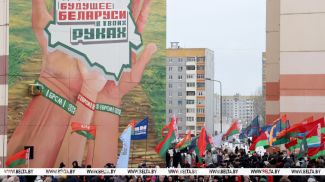The catastrophe at the Chernobyl Nuclear Power Plant happened 35 years ago. It was the largest anthropogenic disaster in the history of humankind. Belarus was the worst-hit country, suffering enormous damage. For Belarus, the catastrophe became a national disaster.
Decontamination activities in the village of Dvorishche, August 1986
Reactor No.4 of the Chernobyl Nuclear Power Plant after the accident, 1986
After the accident. The construction of a repository for contaminated machinery, August 1986
Khoiniki District after the Chernobyl disaster. Chemists measuring radiation levels in the streets of the village of Novoselki, 1986
After the Chernobyl disaster in 1986, the city of Pripyat was abandoned, becoming a ghost town
The village of Chudyany in Cherikov District in the evacuation zone, 1990
The village of Veprin in Cherikov District in the exclusion zone, 1990
More than 3,500 cities, towns, and villages were fully or partially abandoned, almost 500 of them ceased to exist.
Gomel District, burying contaminated villages, 2003
Ahead of evacuation of cattle, December 1986
Khoiniki District after the disaster, 1989
Resident of the village of Lomachi in Khoiniki District, 1989
Patrolling in the abandoned village of Vyazok, May 1991
Chernobyl exclusion zone, 1993
Village of Pirki in Bragin District in the exclusion zone, 1990
Khoiniki District after the catastrophe, 2004
Abandoned fields in the Chernobyl exclusion zone, 1990
Some villagers did not leave the exclusion zone, 1990
In the secondary school of the abandoned village of Zalesie in Bragin District, 1990
The village of Solnechny in Bragin District is part of the tourist route of the exclusion zone, 2019
Since the Chernobyl catastrophe, Belarus has carried out tremendous work: people have been resettled from the contaminated area, provided with housing, jobs, and medical services, the territories have been decontaminated.
Bragin, 2021
Around 5,000 people were resettled from Bragin District after the disaster. At present, Bragin is coming back to life
School students in Narovlya, 2021
Narovlya, 2021
Narovlya District, 2021
Thanks to effective implementation of state programs to cope with the aftermath of the Chernobyl disaster, the economy of the affected regions has been revived. The transition from rehabilitation of the affected territories to their sustainable development is still underway.
Kindergarten in Komarin, Bragin District, 2019
Chechersk in Gomel Oblast, 2020
Ceremony to commission a bridge over the Sozh River in Slavgorod District, 2020
Slavgorod District is one of territories affected by the Chernobyl disaster. In 2020, more than 5,000 square meters of housing was built here and several new enterprises and social facilities were opened. A handful of large-scale projects are running in the district
Honey production in Slavgorod District, 2021
Slavgorod, 2021
The government program on overcoming the consequences of the Chernobyl catastrophe were implemented for 2021-2025 remains focused on people. It is aimed at social protection of the population who suffered from the Chernobyl disaster, enforcement of radiation safety requirements, and intense social and economic development and revival of contaminated territories.
Follow us on:













